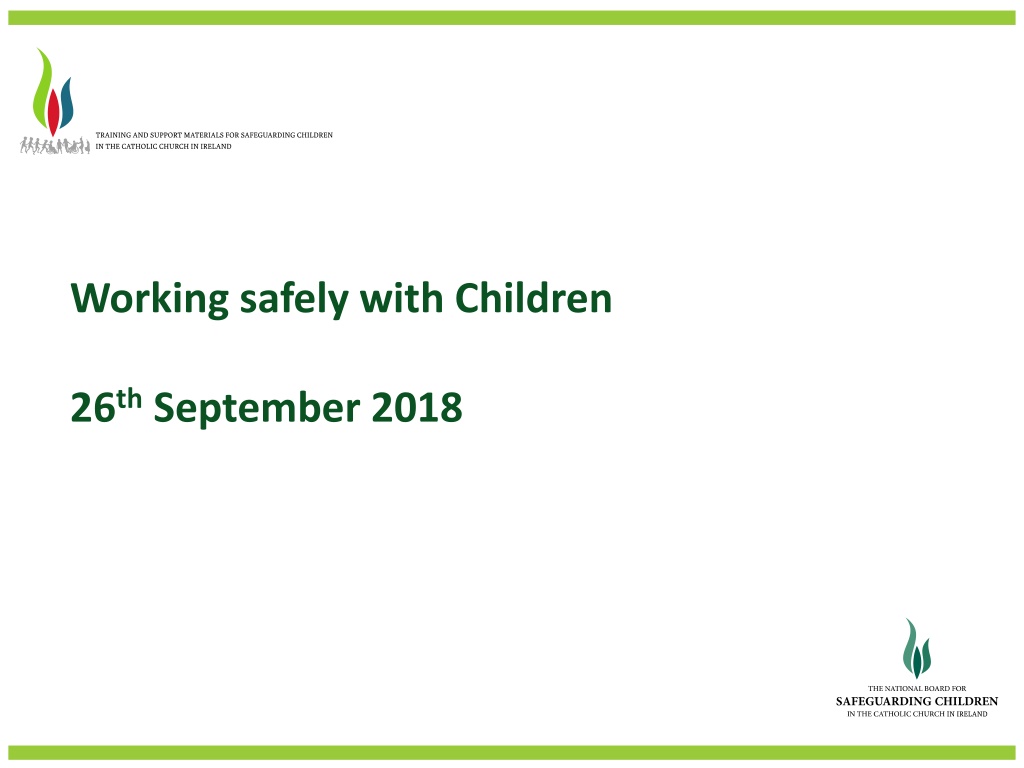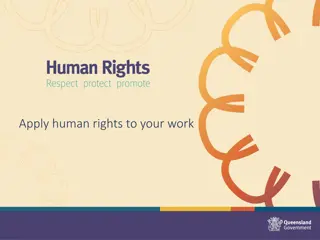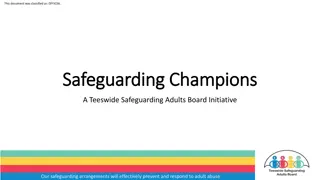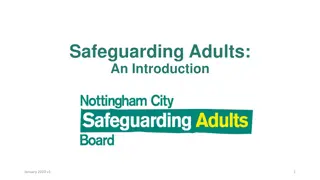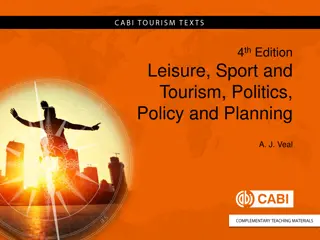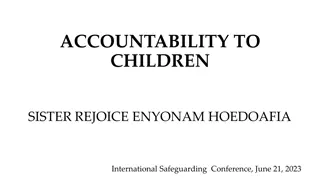Safeguarding Children: Understanding Rights and Responsibilities
Explore the importance of working safely with children, focusing on safeguarding principles and children's rights. The training session covers topics such as children's rights, policy statements, UNCRC principles, and specific rights concerning safeguarding. Participants engage in discussions on challenges faced and share resources to enhance safe youth ministry practices.
Download Presentation

Please find below an Image/Link to download the presentation.
The content on the website is provided AS IS for your information and personal use only. It may not be sold, licensed, or shared on other websites without obtaining consent from the author. Download presentation by click this link. If you encounter any issues during the download, it is possible that the publisher has removed the file from their server.
E N D
Presentation Transcript
Working safely with Children 26th September 2018
Welcome and Introductions Colette
In your group: Introduce yourselves and have a brief discussion on: What you would like to get out of the day? What challenges you are currently facing with regards safeguarding and working safely with children?
Aims: To highlight the link between children s rights and safeguarding To discuss step by step the safeguards that need to be in place to work with children safely To discuss boundaries and serious incident planning To hear from others about resources they have used for encouraging safe youth ministry
Childrens Rights Niall Moore
Policy Statement As a constituent member of the Catholic Church in Ireland, we recognise and uphold the dignity and rights of all children, are committed to ensuring their safety and well-being, and will work in partnership with parents/guardians to do this. We recognise each child as a gift from God, and we value and encourage the participation of children in all activities that enhance their spiritual, physical, emotional, intellectual and social development. All Church personnel (including clergy, religious, staff and volunteers) have a responsibility to safeguard children through promoting their welfare, health and development in a safe and caring environment that supports their best interests and prevents abuse.
UNCRC The UNCRC has been signed and ratified by Ireland- 1992 UK (Northern Ireland)- 1991 Holy See - 1990
UNCRC Principles of Human Rights Equal Inalienable Indivisible
Have a look at rights and highlight those that relate to safeguarding
Rights that relate to safeguarding Article 2- best Interests Article 12- right to have a say Article 13- freedom of expression Article 17- access to information Article 19- protection from abuse Articles 20-27- protection articles Article 34- protection from sexual exploitation Article 35- protection from trafficking Article 36- protection from exploitation of any kind Article 37- protection from inhumane or degrading treatment Article 42- knowledge of rights
In our practice we should be mindful of rights and how we uphold children s dignity to live out their rights
Our generation will show that it can rise to the promise found in each young person when we know how to give them space. This means that we have to create the material and spiritual conditions for their full development; to give them a solid basis on which to build their lives; to guarantee their safety and their education to be everything they can be; to pass on to them lasting values that make life worth living; to give them a transcendent horizon for their thirst for authentic happiness and their creativity for the good; to give them the legacy of a world worthy of human life; and to awaken in them their greatest potential as builders of their own destiny, sharing responsibility for the future of everyone. If we can do all this, we anticipate today the future that enters the world through the window of the young. (Pope Francis 2013: 2)
Working with Children to provide Safeguarding Information Mia Joyce Walsh - Diocese of Galway
Safeguarding leaflet for children and parents
How it came about Identified that there was a gap in providing information to children on safeguarding Discussions with other stakeholders Need to provide this information in a child friendly, age appropriate way
Preparation Decided to approach a group of young people Pope John Paul II Award group Modelled the way in safeguarding Children will be brought up in a spirit of peace, dignity, tolerance, freedom, equality and solidarity (UN Convention on the Rights of the Child) Gave them an idea of what we wanted - remit was to produce a child friendly safeguarding leaflet*
The Result A document for children and young people created by young people Hand drawn artwork, hand written prayer and phraseology all of their own
Difference it has made & feedback Will be launched on 13th October Will be in every church in the diocese and on the website Has been sent to the national office, diocesan safeguarding committee and some parishes
Safeguarding and Youth Ministry step by step Niall
Step 1- Clarity When you are being asked to take on a project involving any aspect of working with young people clarify: Who is responsible What is the purpose What resources do you have
Step 1- Recruitment Make sure everyone is recruited properly (Guidance 1.1A Vetted if appropriate (Guidance 1.1B) If visiting clergy or those in any form of consecrated life that appropriate celebret/letters of good standing and other documentation is in place (Guidance 1.1C and 1.1F)
Step 2 Training and Codes of Behaviour for Adults Once recruitment is complete the person needs to be given an induction. This should include: Full day or information session as appropriate delivered by NBSCCCI Trainer (Guidance 5.3B) Clear code of behaviour (Guidance 1.2A) that deal with: One to One contact (Guidance 1.4D) Boundaries and communication (Guidance 9.1C) Complete induction form (Guidance 5.1A)
Step 3 Selecting a Venue Make sure the venue is suitable for the number of children you have for the activity you plan to do Conduct and document a hazard assessment (Guidance 1.8A) Consider insurance
Step 4 Recruit the Young People How are you going to advertise? Forms that are needed: Consent (1.4A Template 3) Media Consent (1.9A Template 1) Sign in sheets (1.4A Templates 1 and 2) Working with children with specific needs (1.4F)
Step 5 Review Do you have enough adults to young people? (1.4C) Is the venue still suitable? (1.8A)
Step 6 Information for parents/guardians Has full information been given to parents including: Contact details for leaders Safeguarding contacts Complaints procedure (1.7A) Appropriate safeguarding forms
Step 7 First meeting with children Safeguarding Information and training (Guidance 5.5A) Clear code of conduct (Guidance 1.3A) Dealing with breaches of code of conduce (1.3B)
Step 8 Complaints, Whistleblowing and First Aid Procedures need to be in place for: Complaints handling (1.7A) Whistleblowing (1.6A) First Aid (1.4B)
Boundaries Colette
What is Ministry? Comes from Greek word diakonia Serving another s needs Responding to a Vocation Professional
Pastoral Ministry Vocational Communal within a Church not a private calling Professional Competence, integrity, dedication to serve
Ministry Always about the person being served (Important that Ministers have their personal needs met through other fora) The Minister needs to care for the self
Use of Power Always an imbalance of Power Clear boundaries are needed Avoid in as far as possible Dual Relationships
Boundaries Violations emotional, physical, spiritual or sexual
Boundaries The minister is ALWAYS responsible for maintaining appropriate boundaries Ministers choose an appropriate physical environment in which to exercise ministry
Boundaries Confidentiality The seal of Confession is absolute Other information disclosed in ministry is confidential except in very limited circumstances
Limits to confidentiality Clear and imminent danger to the self or others When abuse is involved For supervisory purposes
Boundaries and The Pastoral Relationship Rigid Strong Role Identity Maintains Distance
Boundaries and The Pastoral Relationship Porous Can t say no No time structure Goes beyond competence
Boundaries and The Pastoral Relationship Flexible Knows how to manage Dual Relations Confidentiality
Boundaries Respect/dignity Space Time Competence and Age Appropriate Dress Talk/Communication Touch Social Media Friends
Boundaries Clarity around role In Ministry priority is the other Evaluation/Supervision
Safeguarding Training for Young Leaders Diocese of Down and Connor
Safeguarding in Youth Ministry Pauline Dowd Living Youth
Benefits of the National Standards Why I became a National Trainer The benefits of being a National Trainer Effectiveness of the Training Clear Comprehensive Well Explained Shared one Church Policy Helpful/Useful Actions required are simple but direct Training is easy to deliver People can talk about the Safeguarding with confidence Alternative?
